Projects, whether they’re large or small, are journeys. Project managers are responsible for making sure those journeys go according to plan and to do so, they need to break down projects into phases so they’re easier to manage. A milestone chart can help them do so.
What Is a Project Milestone?
A project milestone is an event that marks an important point in a project timeline or milestone chart. Some examples of project milestones include assembling a project team, beginning a project phase or the delivery of a project deliverable. We’ll dive into the different types of project milestones in more depth below, but first, let’s define what a milestone chart is.
What Is a Milestone Chart?
A milestone chart is a project management chart that helps project managers visualize project milestones. It typically shows each milestone and when it needs to be completed, the status of the milestone (complete or incomplete) and sometimes the priority of the milestone. Many milestone charts use specific colors of symbols to show the most critical milestones.
Related: Project Milestone Chart Template
Milestone charts are typically created using Gantt charts, a horizontal bar chart that represents project tasks and milestones over a project timeline. This is a powerful project planning tool that allows project managers to create a project schedule.
ProjectManager is online project management software that lets you create project schedules and milestone charts in minutes with powerful Gantt charts. Our Gantt charts let you assign work to team members, drag and drop tasks, identify project milestones, collaborate with your team and set a baseline to track project variance in real time. Get started for free.
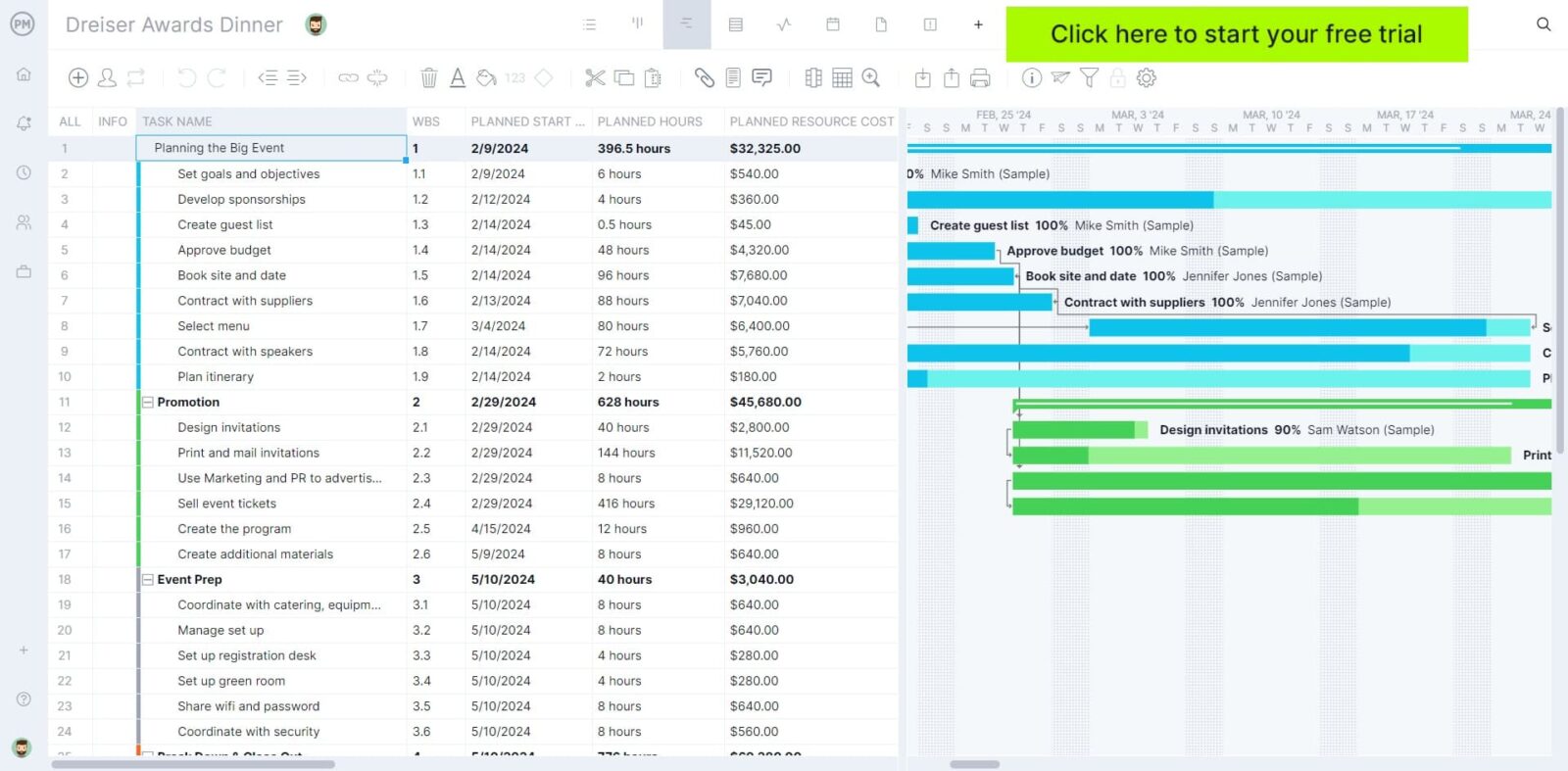
What’s the Purpose of a Milestone Chart?
The primary purpose of a milestone chart is to map out the milestones of a project so they can be easily identified by the project manager, project team members or stakeholders. However, milestone charts are useful for other reasons such as:
- Simplifying project schedules by only showing the most important events
- Facilitating progress report updates for key stakeholders
- Sharing details during project status meetings with stakeholders
- Focusing on project milestones helps teams better prioritize their tasks
- Achieving project milestones help teams stay motivated
What Should Be Included in a Milestone Chart?
We’ve outlined some of the most common parts of a project management milestone chart.
- Project Milestones: These are key events in a project timeline that mark a significant achievement. Each milestone should have a name and due date. Examples include project initiation, requirements gathering, design approval or deployment.
- Project Phases: There are various phases throughout a project that break down the project into smaller and more manageable sections. Typical project phases include initiation, planning, execution, monitoring and controlling and closing.
- Task Dependencies: Task dependencies represent relationships between project tasks to help determine the order in which they need to be completed. The four main types of task dependencies include finish-to-start, start-to-start, finish-to-finish and start-to-finish.
- Key Project Deliverables: These are tangible or intangible deliverables that are produced during a project that represents either progress or completion. These provide clarity on what needs to be accomplished and keep stakeholders informed about progress along the way.
- Task Owners: Task owners on the milestone chart represent who will be responsible for completing each project milestone. This helps the project team better understand what they need to accomplish throughout the project.
- Project Timeline: A project timeline visually represents the project’s schedule to illustrate milestones, key phases, tasks and durations. It’s one of the most beneficial tools to help the project stay on track.
- Resource Requirements: This refers to the needed resources that are needed to complete a successful project. Examples of resources include personnel, materials and equipment. Resource requirements help keep the budget in check and ensure the project has what it needs to meet project objectives
- Estimated Costs: Cost estimation is an essential part of a milestone chart to help the project stay within budget. Examples of estimated costs include direct, indirect, fixed, variable and contingency costs.
Milestone Chart Example
As a milestone chart example, let’s consider a hypothetical apartment building project that will house over 100 units. It will be located in a growing urban area to cater to families, young professionals and retirees alike. The complex itself will be a mixture of one, two and three-bedroom units. As there will be a lot of tasks in this project, a milestone chart is the best tool to simplify the project planning, scheduling and reporting process. This is because it focuses on putting the most important things (milestones) in the schedule.
The project will kick off with design and planning where architects will work to create a blueprint. Once zoning approvals and construction permits are obtained, the site will be prepared. Next comes the foundation phase including structural framing followed by HVAC system installation. As the project progresses and final inspections are eventually completed, an occupancy permit will be issued.
In this milestone chart example, regular updates help to keep the chart updated so that the current milestone status is updated. It also provides an easier way to communicate with stakeholders as they follow along the project’s progress.

The above milestone chart example image has the Gantt chart task list on the left next to the bar graph on the right. Each milestone is represented by the diamond symbol and the lines underneath them show the duration of project phases.
How to Create a Milestone Chart
The best way to create a milestone chart is to use project management software tools such as online Gantt charts, task lists and project calendars. ProjectManager has these and other project planning, scheduling and tracking tools. Here are some steps to create a milestone chart using ProjectManager or other similar project management software. To get started, simply start a free trial of ProjectManager and open the Gantt chart view.
1. Create a Task List
No matter the scheduling tool you choose, you must create a complete task list. New tasks will naturally occur throughout the project lifecycle, but the original task list should be as exhaustive as possible. A detailed task list simplifies the process of identifying primary and secondary tasks and charting the best location for a milestone.
Below, the milestone lists consist of examples such as design and planning, permits, site preparation, foundation, structural framing and HVAC.
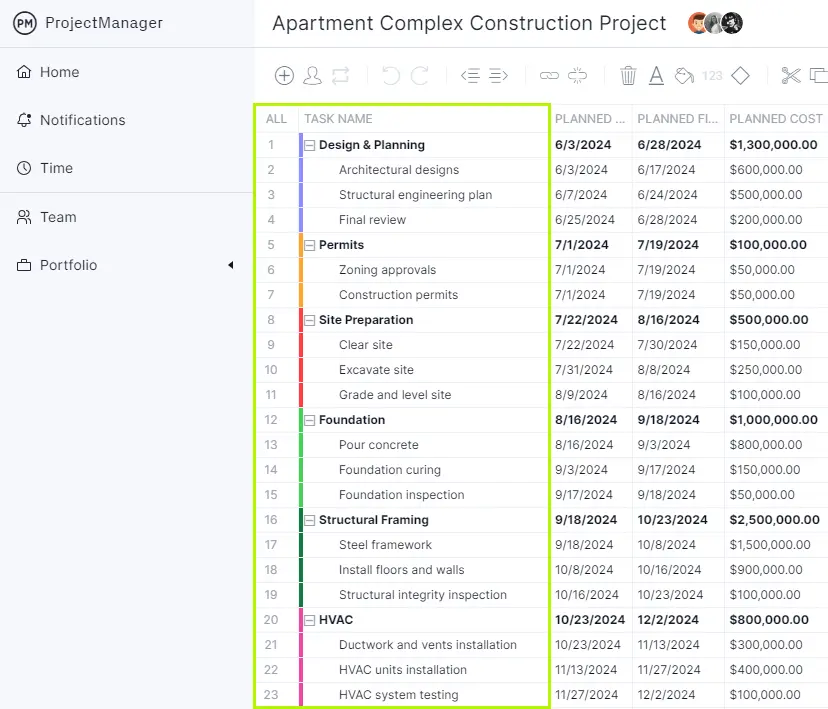
2. Schedule Tasks on a Gantt Chart
Once you’ve created a task list and documented the necessary details—task name, assignee, start date, end date, etc.—you now have all the information you need to schedule these tasks on a Gantt chart. Input the information you’ve already gathered and view your project plan in seconds.
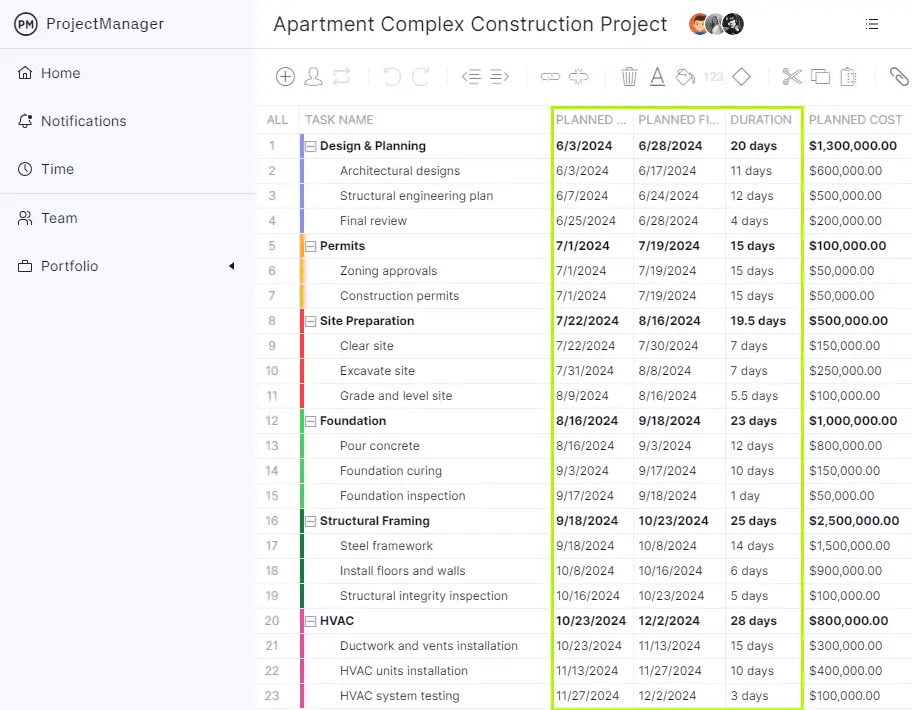
From here, make changes and adjustments by dragging and dropping task bars. All of the above planned start and finish dates are represented by the colored bar charts. If the dates change in the columns, the bar charts will adjust automatically.
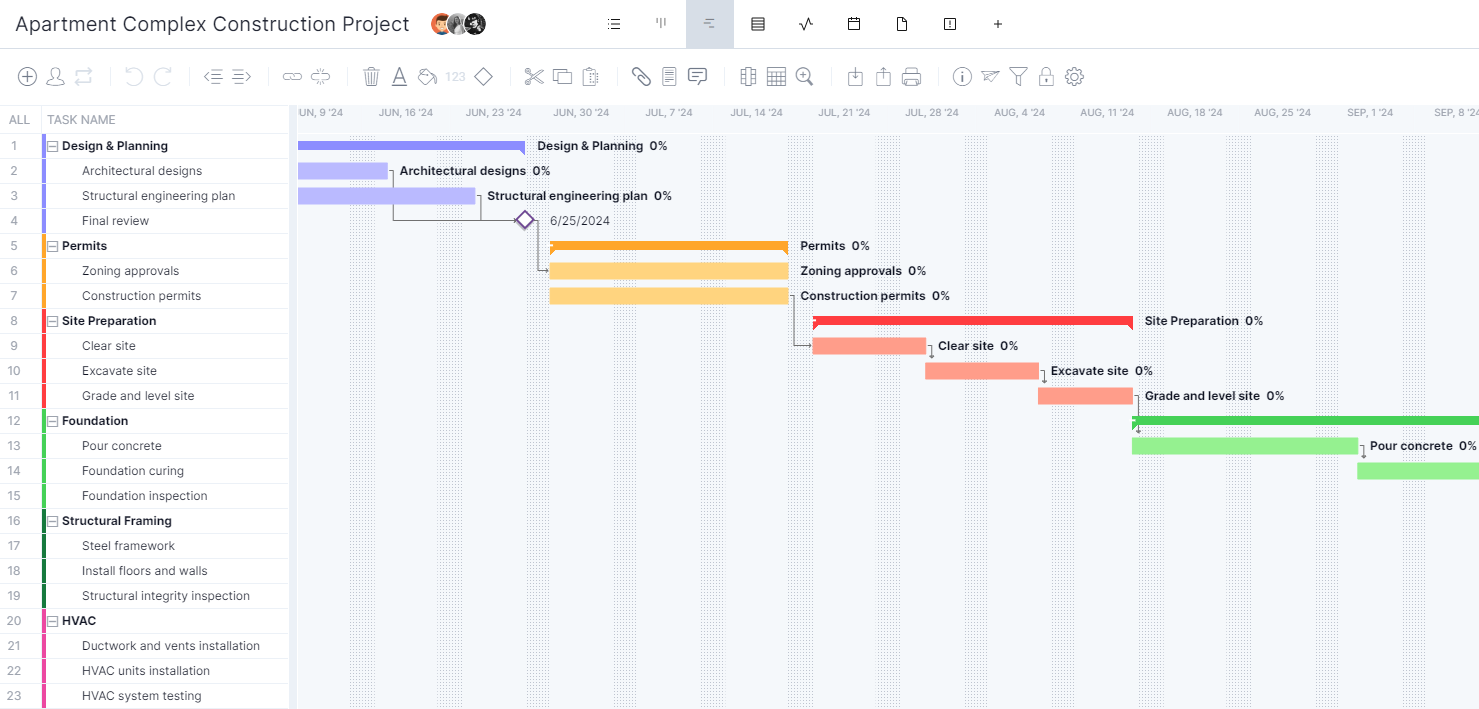
3. Identify and Link Task Dependencies
Now, identify the task dependencies, or the relationships between tasks and the order in which they need to be completed to meet the project success criteria. Unlike many other online Gantt charts, ProjectManager’s Gantt chart can link all four types of task dependencies to help better plan, schedule and manage the project.
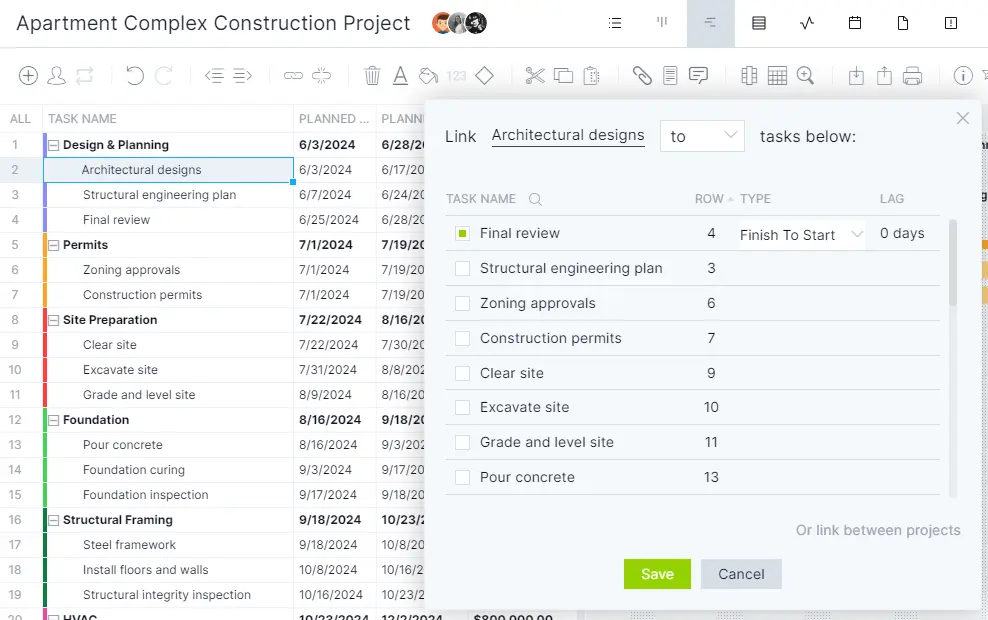
4. Determine Project Phases
Using a Gantt chart to make a milestone schedule means you’re almost automatically able to visualize your project in phases by analyzing and categorizing tasks. As shown above, each bar represents a different task and different colors can represent different project phases.
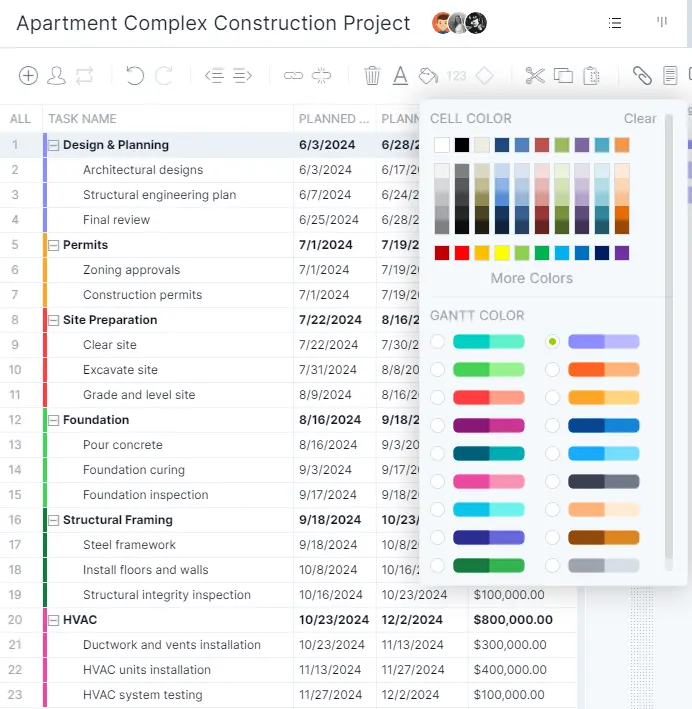
When you color-code project phases, placing milestones is nearly effortless. Once you decide where to put them, it’s only a matter of a few clicks.
5. Place Milestones
Modern project management tools like ProjectManager make setting milestones effortless. When you’ve created your schedule and decided which task completions qualify as milestones, enter milestone details and share the information with your team so everyone can see.
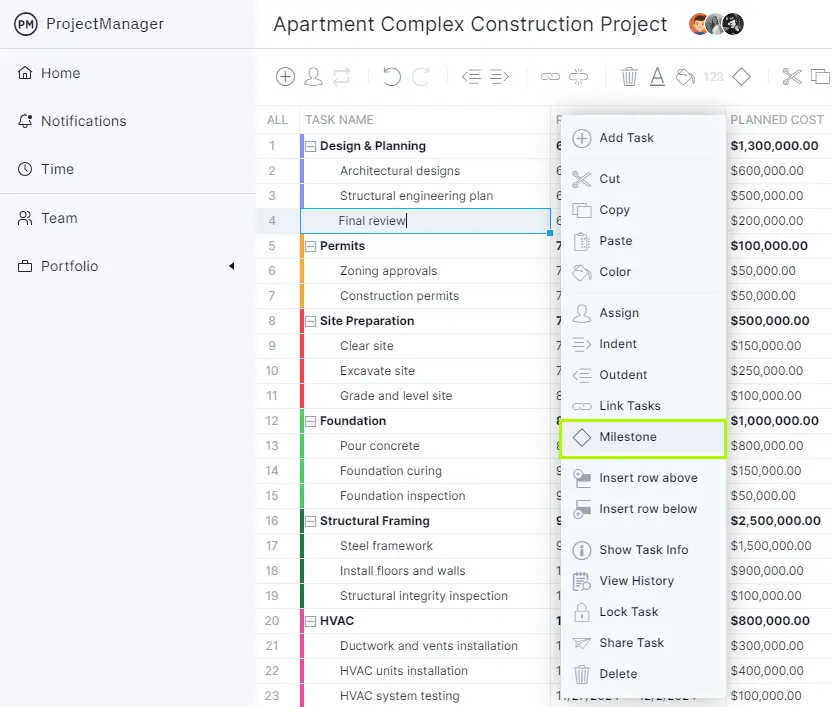
When you’ve placed your milestones, these achievements can be represented by a small diamond symbol that won’t clutter the schedule, as shown in the image below.

6. Assign the Completion of Milestones to Team Members
Make sure to assign milestone completion to the ideal team member so they are aware that they need to mark it off when they are finished. This lets everyone on the team better understand how the milestone chart is progressing.

7. Estimate Resource Requirements and Costs
There’s a place to add specific resource requirements and costs so everyone on the team understands who or what is needed to complete the corresponding milestone.
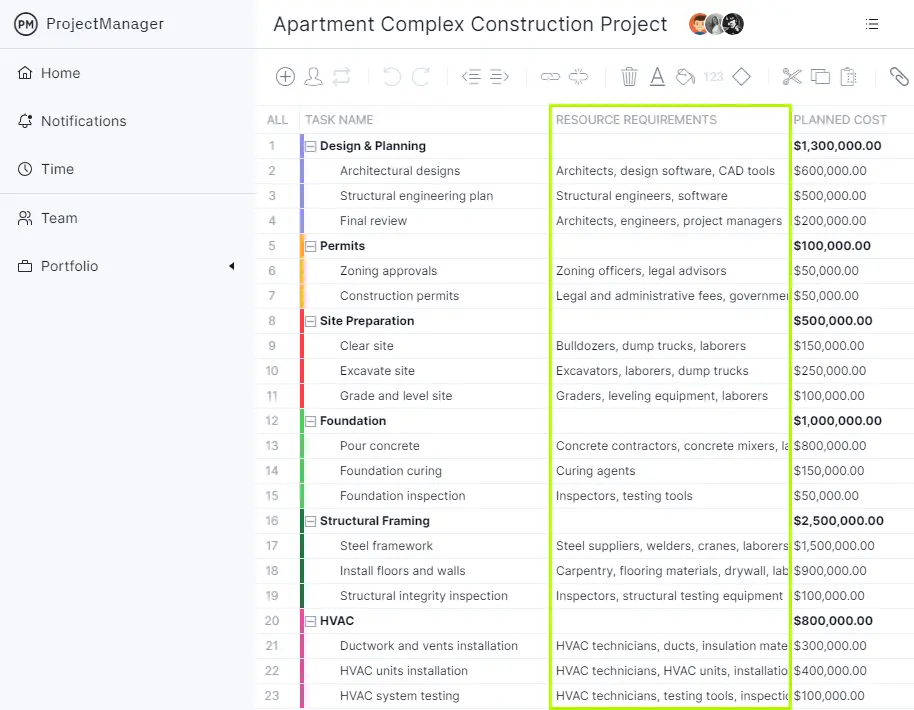
Project Milestones Examples
Milestones differ from project to project, depending on project size, scope and team size. Still, most milestones take similar forms and are used to represent events like:
- Meetings
- Sign-offs
- Approvals
- Beginnings of different tests
- Construction phase completions
As you can see, these are significant events in a project lifecycle. If these don’t happen, the project won’t move forward. By highlighting them as milestones, you illustrate their importance.
Milestones often come at the end of project phases, but this isn’t a hard and fast rule. They can exist mid-phase and even act as the final push team members need to complete the phases. Milestones are among the most useful management tools a project manager can deploy to excite team members and maintain momentum to drive a project forward.
Project Milestone Chart Template
To get a better understanding of how to use milestones in a real project plan, try ProjectManager’s free project milestone chart template
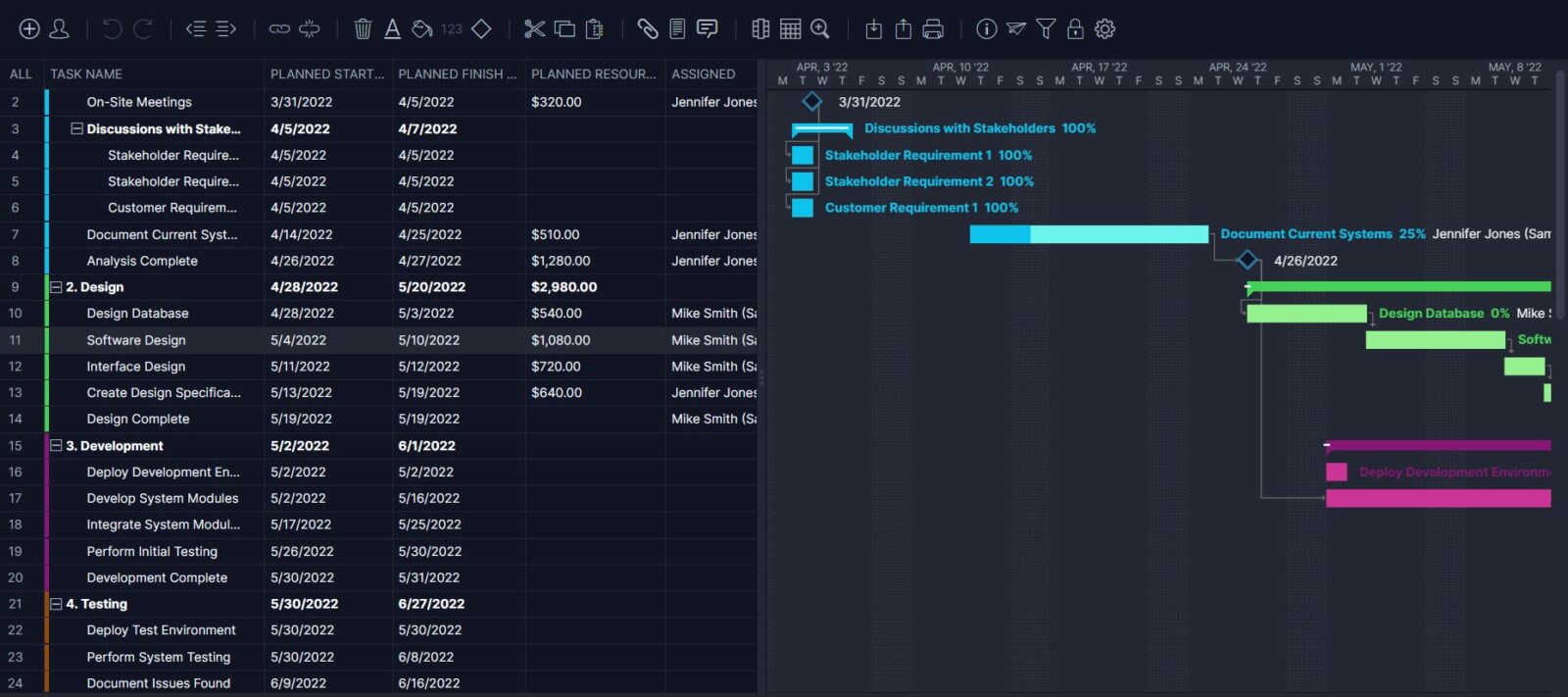
The project milestone chart template opens in the Gantt chart project view of ProjectManager. This free milestone planning template sets up the project plan, with the tasks to the left and the timeline to the right. As you can see, the diamond icons on the right indicate where there’s a milestone. You can easily add them on any important date, such as when you assembled a team, the completion of a task, etc.
The milestones in ProjectManager’s free milestone schedule template can be set to start-to-start, start-to-finish, finish-to-finish and finish-to-start. That way you can easily determine which of the four types of project milestones it is.
Free Project Management Templates
Milestone charts are a useful project management tool. However, you’ll need more than a milestone chart to manage your projects. That’s why we’ve created free project management templates to help you better plan, schedule and track. Here are some of them.
Gantt Chart Template
As stated above, milestone charts are created using Gantt charts. Our free Gantt chart template is a great place to start documenting your project tasks and due dates. Then, export the data into ProjectManager where you can set milestones, identify the critical path, assign tasks, set due dates and create a project schedule.
Project Dashboard Template
Having a project management dashboard to quickly monitor your project’s health is very important. Our free project dashboard template helps project managers keep track of project tasks, costs and workload.
Task Tracker Template
Project milestones can’t be achieved without completing project tasks. Our free task tracker template helps you track all your project activities so nothing slips down the cracks.
Benefits of Creating a Milestone Chart With ProjectManager
When you manage your schedules with an award-winning online project management tool like ProjectManager (you can sign up for a free trial here), milestones are represented on Gantt charts with a small diamond sitting on the schedule in relation to tasks.
Simplify Project Planning, Scheduling and Monitoring
ProjectManager’s award-winning Gantt chart is the ideal place to plan, schedule and monitor project milestones. Use it to add task details including priority, due dates, task dependencies and more. If things change throughout the project, simply update the Gantt chart and all other project views will update automatically. It’s never been easier to keep your project on schedule.
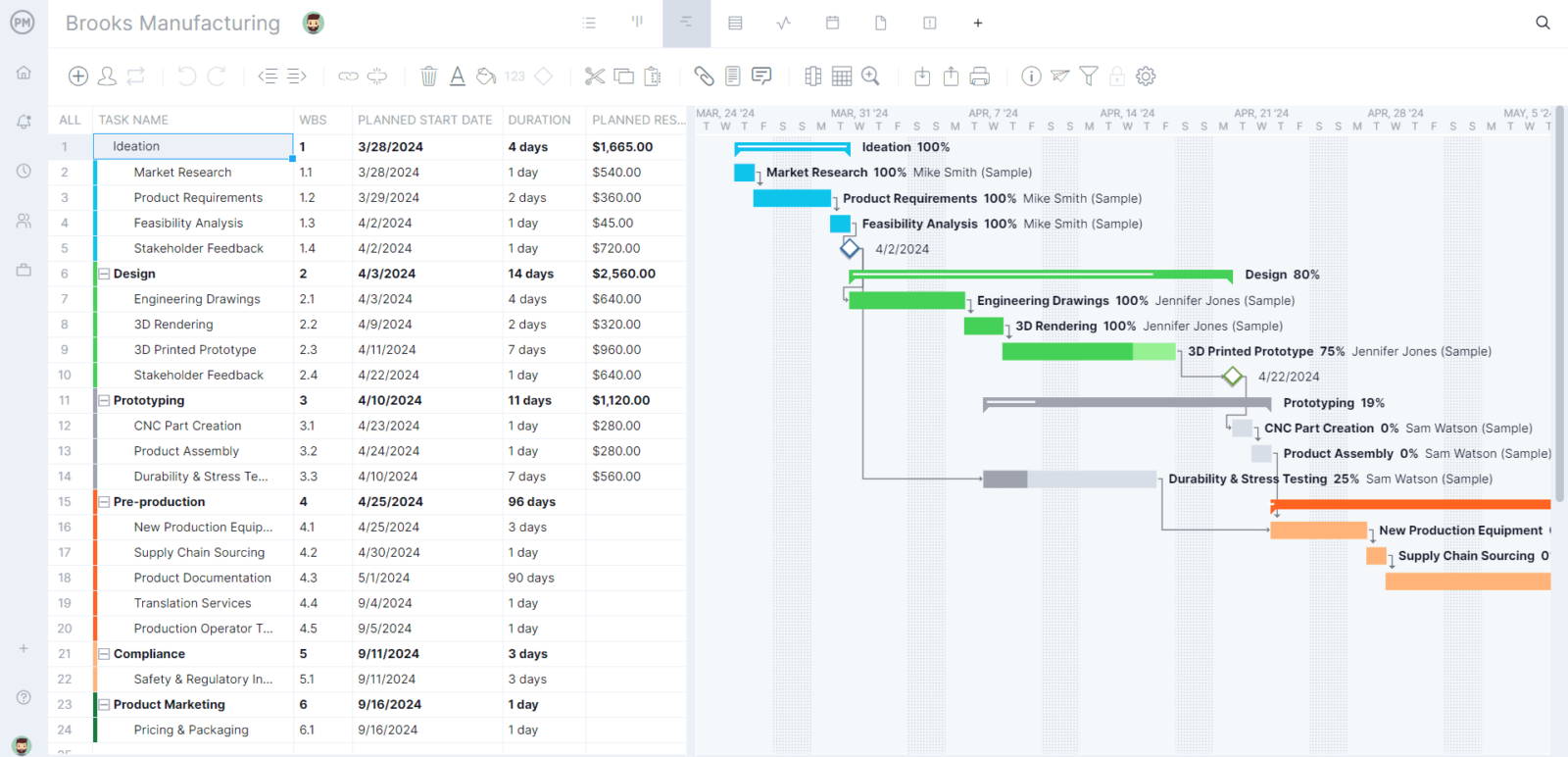
Track Projects with Real-Time Project Dashboards and Reports
While milestone charts are incredibly helpful, other team members might want to track project data in other views. ProjectManager’s real-time project dashboards, including the portfolio dashboard, are the perfect way to get a high-level view of key project data. To keep stakeholders informed, browse the various types of project reports that can help keep stakeholders informed on various project aspects.
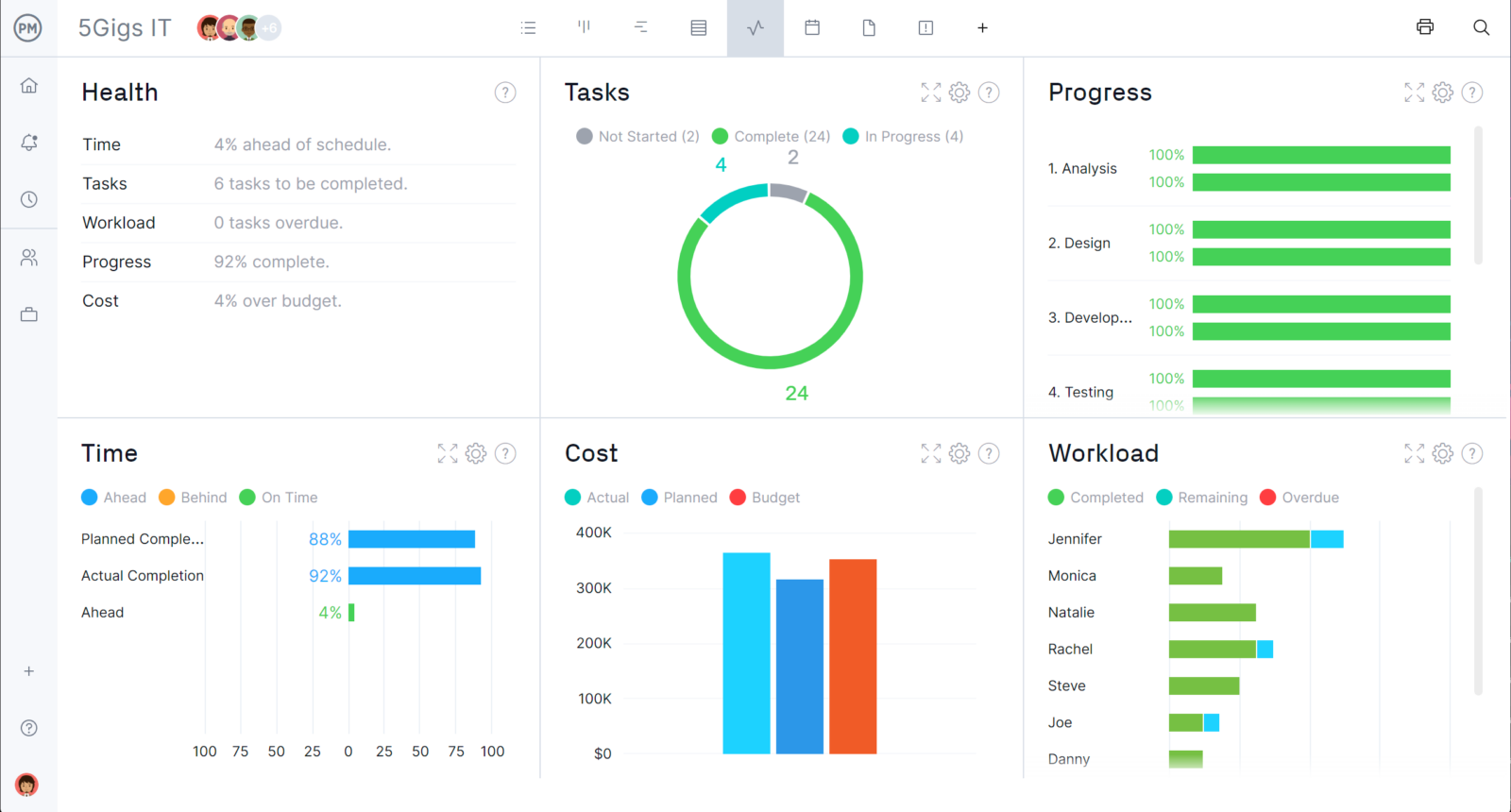
This eliminates the need to refer to different charts simultaneously and risks confusion along the way. The best part? It’s easy to make changes from anywhere you work by dragging and dropping the diamond icons.
Collaborate in Real-Time
Our Gantt chart gives your team an interactive platform for collaboration. They can view their team member’s progress on tasks and share comments and files on the task level. You can even set up automatic alerts to make sure milestones are met.
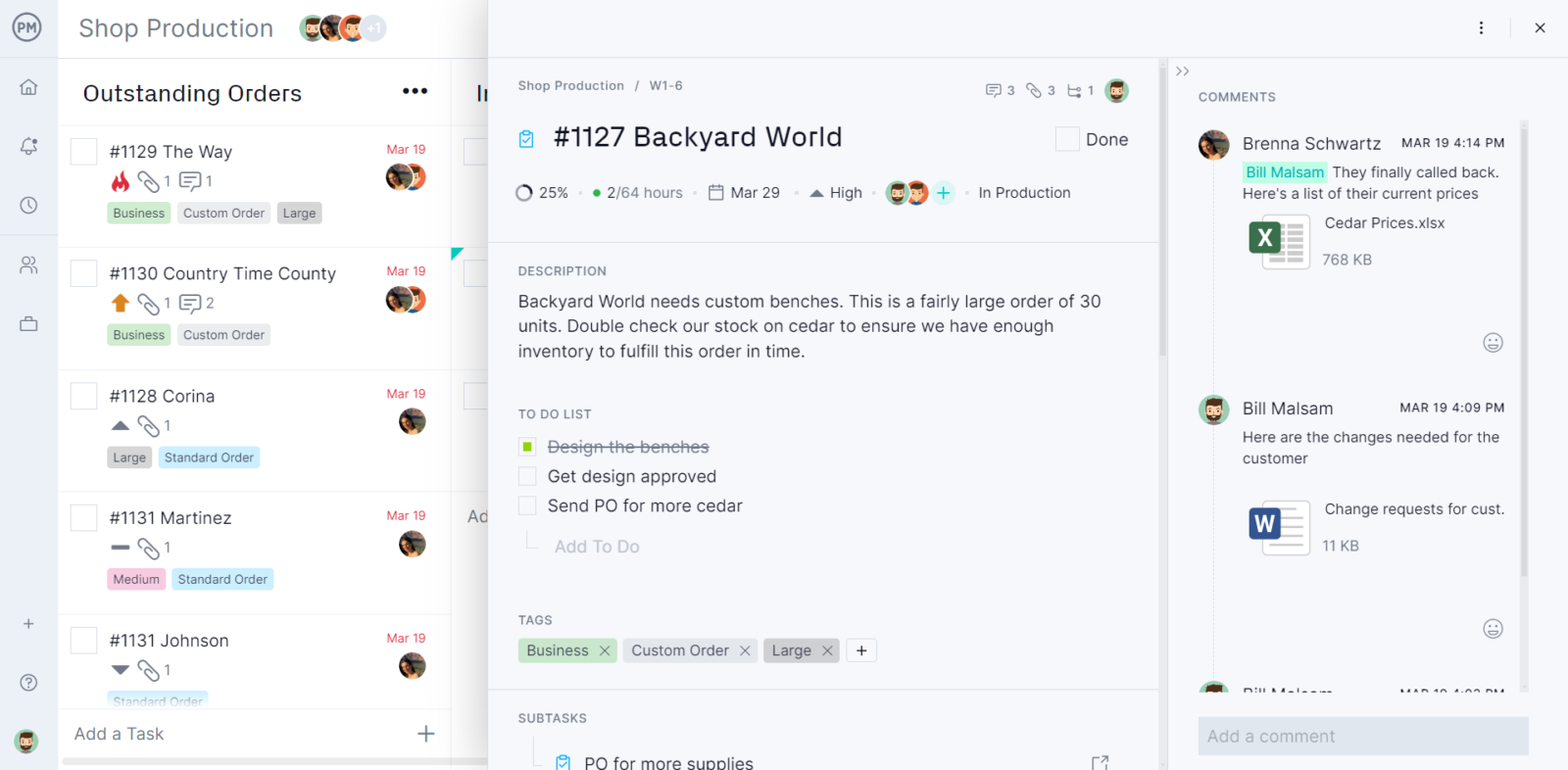
When you need to report your progress on reaching milestones to your stakeholders, ProjectManager has both a dashboard to track progress in real time and one-click reporting to generate shareable reports for anybody who needs them. Milestones have never been easier to use!
Related Content
Milestones are only one of the vast suite of project management tools you get when you sign up for ProjectManager. Our online project management software gives you robust online Gantt charts with milestones, real-time data, and a collaborative platform to make your team more efficient and productive. See for yourself by taking a free 30-day trial today!

